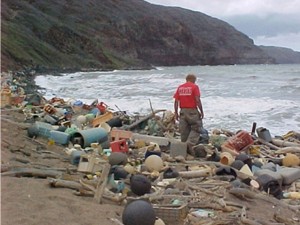Your cart is currently empty!
Update on the Pacific Garbage Patch………..We’re just not getting it!
Found this article on Linkedin at one of my eco friendly groups. Stop, think and remember: If our garbage were placed in our own backyard, how much differently (consciously) would you live? ;-)
Posted on May 30, 2012 in Water Conservation by Matthew Speer
The Great Pacific Garbage Patch is a true testament to the ignorance of our modern world when it comes to the environment around us. As you take a swig from the BPA laced plastic water bottle that was brought back from the grocery store in a single use plastic bag, think about what happens when they are both tossed away. This discarded plastic and other litter often ends up in our oceans and thanks to strong ocean and wind currents it creates an enormous mass of floating plastic spanning thousands of miles. The lifestyle of wasteful convenience experienced in America and other industrialized nations has allowed the Great Pacific Garbage Patch to grow at an estimated hundred-fold in the past four decades.
The Pacific Ocean has become the world’s largest landfill in an area known as the North Pacific Subtropical Gyre. This area boasts a slow moving group of spiral currents that create an oceanic desert with very little sea life. These currents also create an odd side effect, collecting floating trash from around the globe and focusing it in this one region. According to studies by the United Nations Environment program, it is estimated that every square mile of ocean contains 46,000 pieces of plastic, an alarming figure that has likely grown since the 2006 study. A significant portion of this garbage consists of small particles of plastic floating just beneath the surface, this makes measurements more difficult. Based on sampling data it is estimated that the Great Pacific Garbage path could make up 8.1 percent of the entire Pacific Ocean or 5,800,000 million square miles.
The infamous Japanese Tsunami caused enormous amounts of damage and ravaged the island nation, washing homes, businesses and lives out to sea. The debris from this tragedy is now caught up in the Pacific’s currents and is beginning accumulate, adding to the already littered Great Pacific Garbage Patch. The trash that isn’t stuck in the currents has also begun to wash up on the west coast of the United States in places such as Oregon, Washington and Alaska.
The obsession we have with single use plastics and other non-reusable items is the root cause for a large portion of this mess. Prevention is really the only logical step we can take at this point as clean-up measures would prove implausible. Instead we should implement some basic methods that can help curb the rapid growth of the debris field, allowing Mother Nature to work on cleaning up our existing mess. The following tips can help you take action in preventing the spread of the Great Pacific Garbage patch and help create a sustainable earth at the same time.
- Ditch the Plastic Water Bottles: Two million plastic water bottles are used in the United States every five minutes. The water bottles are known to be laced with BPA which can cause birth defects and weight gain. Grab a reusable water bottle to help you stay healthy and go green by reducing the plastics tossed away. Buy a reusable water bottle now.
- Take Your Own Bags: I never did understand the plastic bag concept, reusing bags just made sense economically and for the planet. By taking your own reusable shopping bags you can reduce the litter from finding its way into the ocean and lower the supermarkets operating costs, which could be passed to you in savings. Find reusable shopping bags on Amazon now.
- Travel on Cruise Lines with Ocean Friendly Policies: Up to 20 percent of the trash found in the Great Pacific Garbage Patch is thought to be related to ships dumping trash. Many of the top tier cruise lines are no adhering to strict “no dumping” and recycling policies. This is great for business as the cruise line industry relies on a clean ocean to draw passengers on board.
I am a father of three and I often wonder what shape the planet will be in when we pass it along to the next generations. The Great Pacific Garbage, sadly, was preventable, though our desire for convenience and money led us to poor decision making over the past few decades. Let’s take a lesson from our previous generations and think about using products that last and put our kids first, not our portfolio.
So folks, remember “Be the Change” you wish to see.
Salut!


Leave a Reply